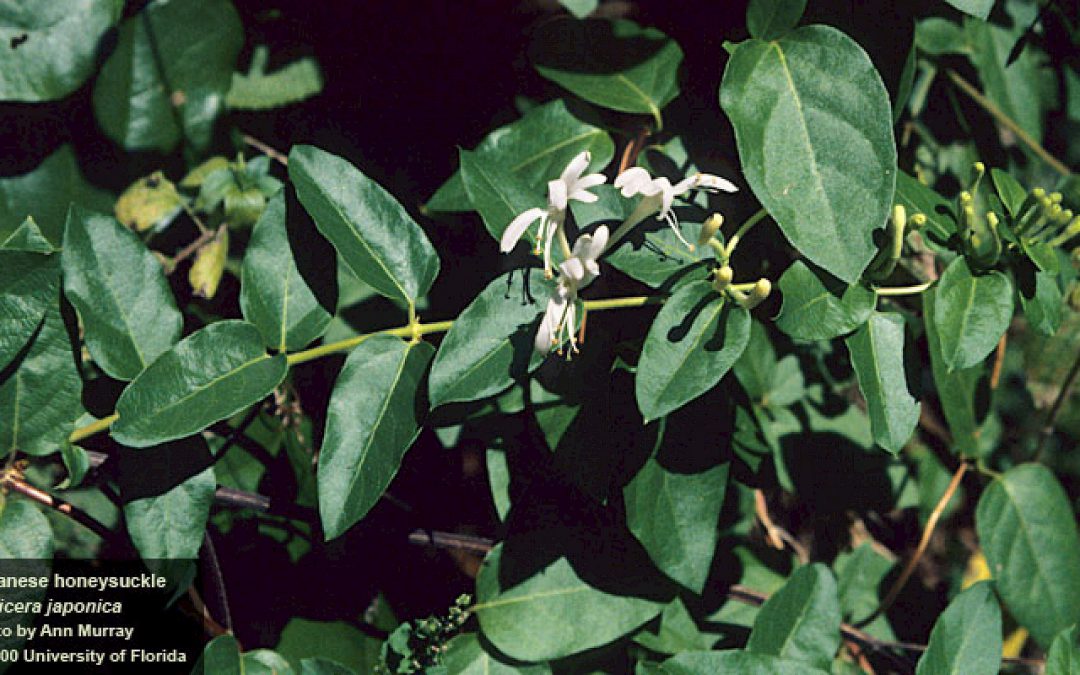
by Rick O'Connor | Feb 18, 2022
Six Rivers “Dirty Dozen” Invasive Species
Japanese Honeysuckle (Lonicera japonica)
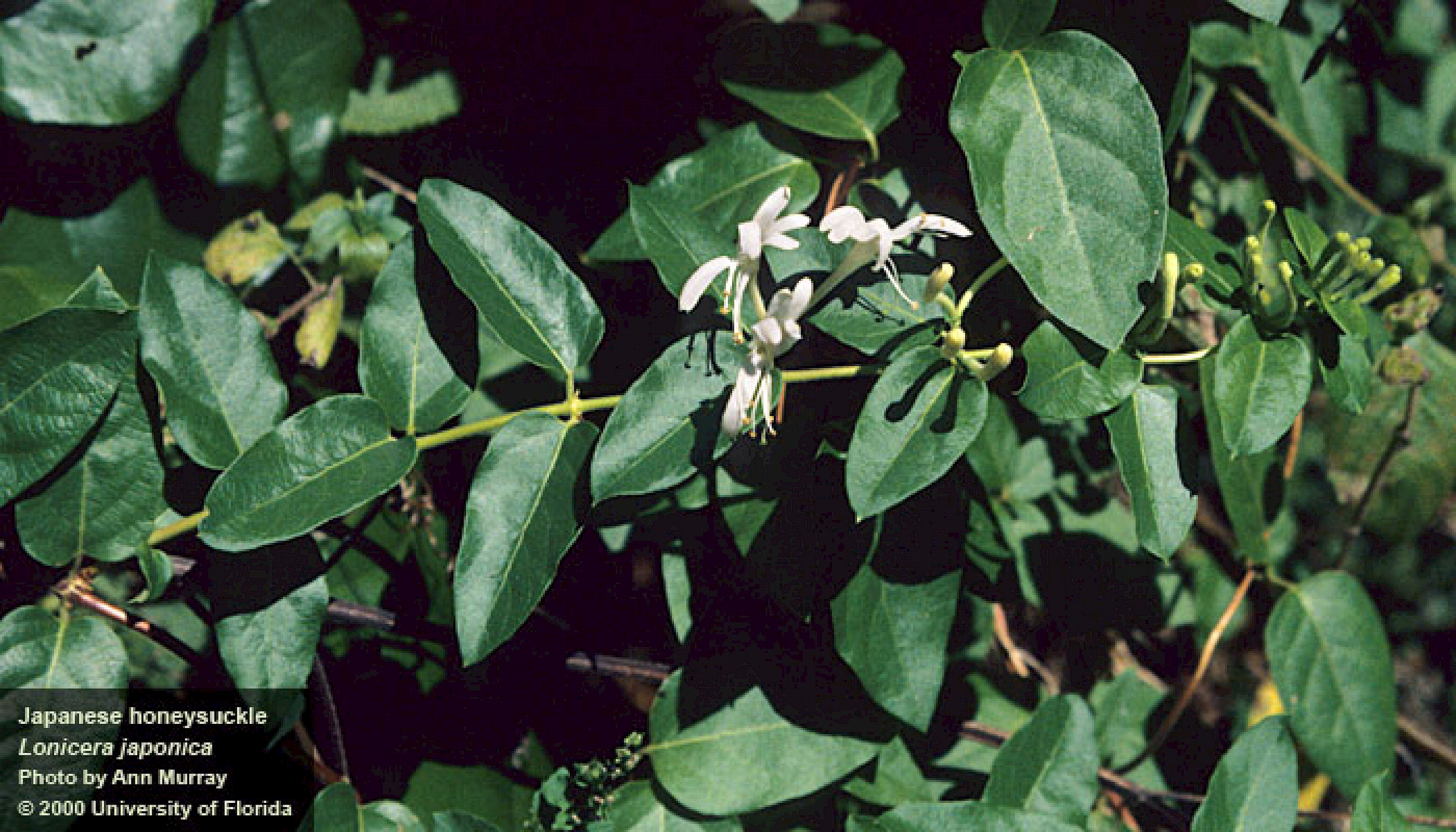
Japanese Honeysuckle
Photo: University of Florida
Define Invasive Species: must have all of the following –
- Is non-native to the area, in our case northwest Florida
- Introduced by humans, whether intentional or accidental
- Causing either an environmental or economic problem, possibly both
Define “Dirty Dozen” Species:
These are species that are well established within the CISMA and are considered, by members of the CISMA, to be one of the top 12 worst problems in our area.
Native Range:
Japanese honeysuckle is native to China, Japan, and Korea.
Introduction:
Japanese honeysuckle was first introduced to Florida in 1875 for agricultural and gardening purposes. It was introduced as a forage plant in the agriculture industry and was very popular as a landscape plant due to its beautiful showy flowers. Its invasive nature was quickly discovered and is now listed as a Category I invasive plant and a Florida noxious weed.
EDDMapS currently has 115,101 records of this plant across the country. Most are east of the Mississippi River but cover the entire east coast, including New England. There are records in the southwestern part of the U.S. In Florida, most of the records are in the northern part of the state, particularly in the panhandle. There are few records south of Orlando. Within the Florida panhandle there are 1,558 records and 1,209 within the Six Rivers CISMA. As with most species, this is probably underreported.
Description:
Japanese honeysuckle is a woody vine that produces beautiful white flowers. These flowers have multiple sepals, and the stamens which extend outward resembling “whiskers”. The leaves are about 1-3 inches, ovate is shape, and opposite on the stem. The small fruits are green and hard when immature, black and soft when older.
Issues and Impacts:
This is an aggressive growing vine that can quickly take over the landscape. It can cover small shrubs and trees killing them, block sunlight so germination of other plants is impossible, and outcompete native plants for needed sunlight decreasing the biodiversity within the area.
Management:
Removing by hand or shovel is effective on small patches. Mowing small patches has found to reduce seed spread but the parent plant may return with additional stems. Mechanical tillage can be effective but can enhance seed dispersal from the seed bank and is not always an option in some locations.
Chemical treatment with either glyphosate or triclopyr has been effective however, cut stump application is recommended. Foliar sprays that do not reach ALL leaves can induce resprouting.
There are no known biological controls at this time.
For more information on this Dirty Dozen species, contact your local extension office.
References
Japanese Honeysuckle. University of Florida IFAS Center for Aquatic and Invasive Plants
https://plants.ifas.ufl.edu/plant-directory/lonicera-japonica/.
Lonicera japonica. University of Florida IFAS Assessment. https://assessment.ifas.ufl.edu/assessments/lonicera-japonica/.
Early Detection and Distribution Mapping System (EDDMapS)
https://www.eddmaps.org/
Six Rivers CISMA
https://www.floridainvasives.org/sixrivers/
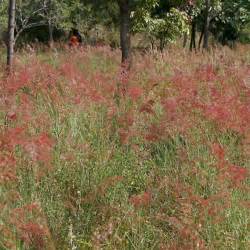
by Rick O'Connor | Feb 11, 2022
EDRR Invasive Species
Natal grass (Melinis repens)

Natalgrass
Photo: University of Florida IFAS
Define Invasive Species: must have ALL of the following –
- Is non-native to the area, in our case northwest Florida
- Introduced by humans, whether intentional or accidental
- Causing either an environmental or economic problem, possibly both
Define EDRR Species: Early Detection Rapid Response. These are species that are either –
- Not currently in the area, in our case the Six Rivers CISMA, but a potential threat
- In the area but in small numbers and could be eradicated
Native Range:
South Africa
Introduction:
Intentionally introduced as a forage plant but lacks the nutritional value of other introduced forage plants.
EDDMapS currently list 3,923 records of this plant, all are across the southern United States from California to Florida. 3,591 reports are from Florida itself, with 53 of these in the Florida panhandle, and 31 of those within Six Rivers CISMA.
Description:
This reddish colored grass can cover large areas of open fields. The reddish color comes from the hair-like structures that are associated with the flowers and will become gray with age. The flowers themselves are a pink-purple in color and are produced from panicles (a cluster of small flowers) that are 4-8 inches long. The grass can reach a height of 40 inches and dispersal is by wind blown seeds.
Issues and Impacts:
It aggressively grows in open fields and displaces native grass species from these areas. Many of which are important to local ecology.
Management:
Hand removal of small patches can be effective, but the property owner should be aware of the ease of seed dispersal when doing this, it is recommended to remove prior to going to seed. It tends to quickly invade open areas of disturbance including the use of fire. Mowing does not provide control.
The herbicides glyphosate and imazapyr have shown to have good control but must be used prior to going to seed. Both herbicides are non-selective, and care must be taken not to treat native plants. Imazapyr has a longer soil life and replanting the area after treatment may not be effective for several months.
There are no known biological controls at this time.
If you are in the Florida panhandle area and believe you may have natal grass, please contact your county extension office to let them know as well as report the siting to www.EDDMapS.org. If you have questions on how to do this, your county extension office can help.
For more information on this EDRR species, contact your local extension office.
References
University of Florida IFAS Center for Aquatic and Invasive Plants. Natal Grass. https://plants.ifas.ufl.edu/plant-directory/melinis-repens/.
Early Detection and Distribution Mapping System (EDDMapS)
https://www.eddmaps.org/
Six Rivers CISMA
https://www.floridainvasives.org/sixrivers/
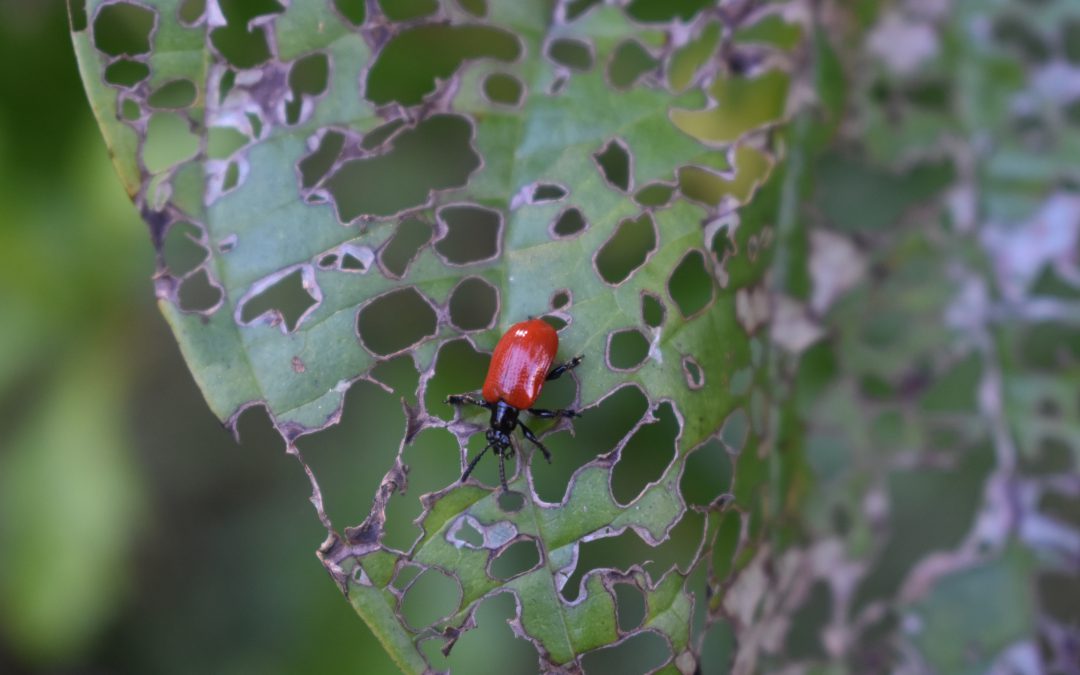
by Danielle S. Williams | Feb 3, 2022
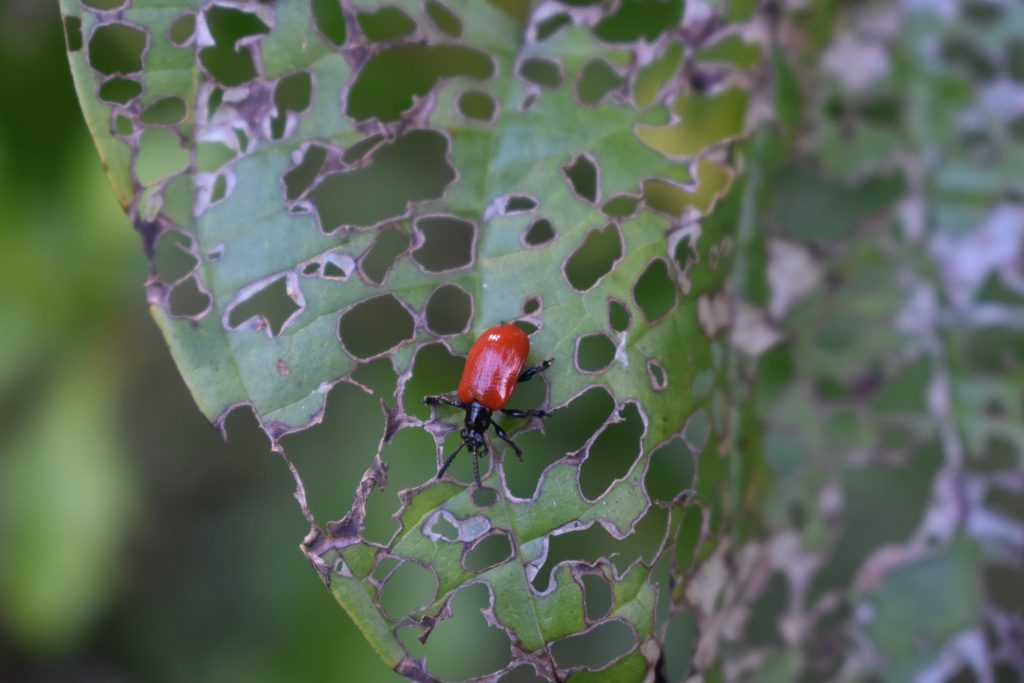
Air Potato Leaf Beetle
I’m sure many of you could easily recognize air potato with its winding vines and heart-shaped leaves climbing high along roadsides, fencerows and natural vegetation, but could you recognize its key predator, the air potato leaf beetle? Believe it or not, a small, red leaf-feeding beetle was introduced and is here to help control the invasive air potato vine!
The Issue with Air Potato Vine
Air potato (Dioscorea bulbifera) is a plant species that is native to Asia and was first introduced to the United States as a landscape plant but has now become one of Florida’s most problematic invasive plants. Air potato has spread to 60 of the 67 counties in Florida, including many in the Panhandle. Air potato vines can grow up to 8 inches per day! The dense vines smother vegetation and displace native plants, trees and animals. The air potato vine is on the Florida Noxious Weed List. This means that is illegal to plant, propagate or move the air potato unless you have a permit.
The air potato vine spreads by vegetative reproduction. This is through the formation of aerial tubers, or bulbils that are formed in the leaf axils. The aerial tubers are roundish and vary in size. In addition to aerial tubers, air potato also produces underground tubers, making control that much more difficult. During the winter, the aerial tubers will drop to the ground and give rise to new vines in the spring.
Park managers and homeowners throughout Florida have battled with the air potato as its covered our landscape. For years, the primary means of control were by manually pulling, digging and destroying the tubers or by herbicide applications, until recently.
Classical Biological Control of the Air Potato Vine
Another method for controlling invasive plants is with classical biological control. This method involves searching for insects that feed exclusively on a plant in its native range and releasing them in an area that has been invaded by the plant. Scientists with the United States Department of Agriculture discovered the air potato leaf beetle (Lilioceris cheni) that feeds on air potato in its native range of Asia. After extensive testing, scientist found that the beetle is species-specific and poses no risk to other plant species.
In 2012, air potato leaf beetles were first released in Florida to help battle the air potato. Now, according to the Florida Department of Agriculture and Consumer Services (FDACS), they are officially established in the state! This means, they are here to stay and research has shown they are helping!
While you likely won’t see the beetles now, because they are overwintering (a period of suspended development), look for them in the spring! Adults are bright red with a black head and legs and about the size of your pinky fingernail. The females lay white, pale eggs on the underside of leaves. The egg-laying process causes the leaves to curl and cup. In addition to that, larvae feed on the leaves skeletonizing them. This feeding by the beetle negatively affects the growth and reproduction of the plant.
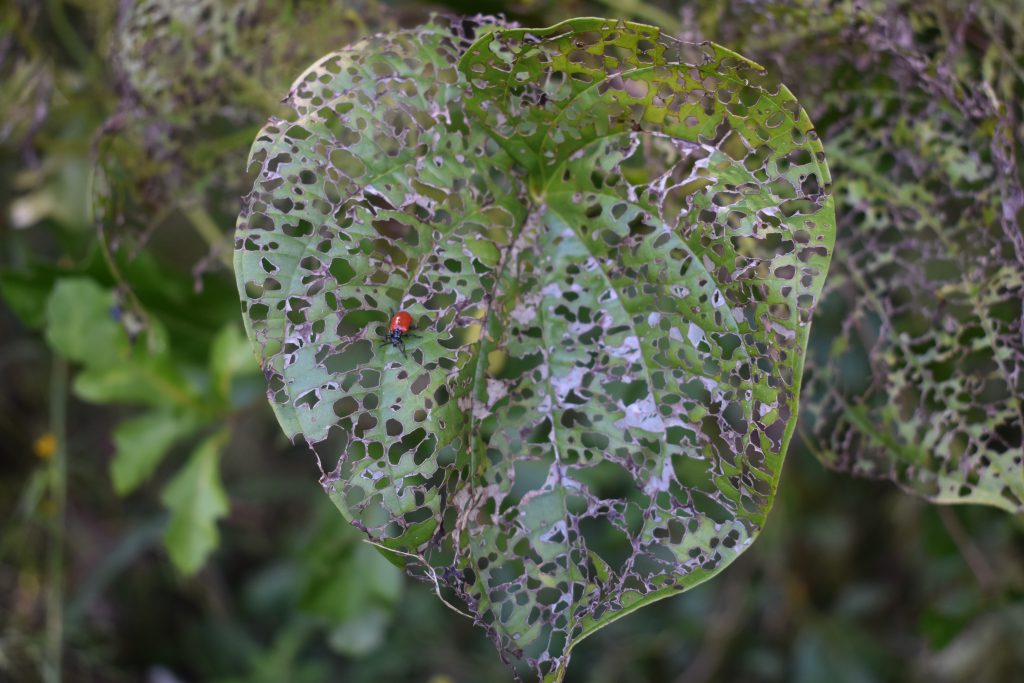
Skeletonized leaf damage to Air Potato from the Air Potato Leaf Beetle. Photo: Danielle Sprague
For more information on air potato leaf beetles, please visit:
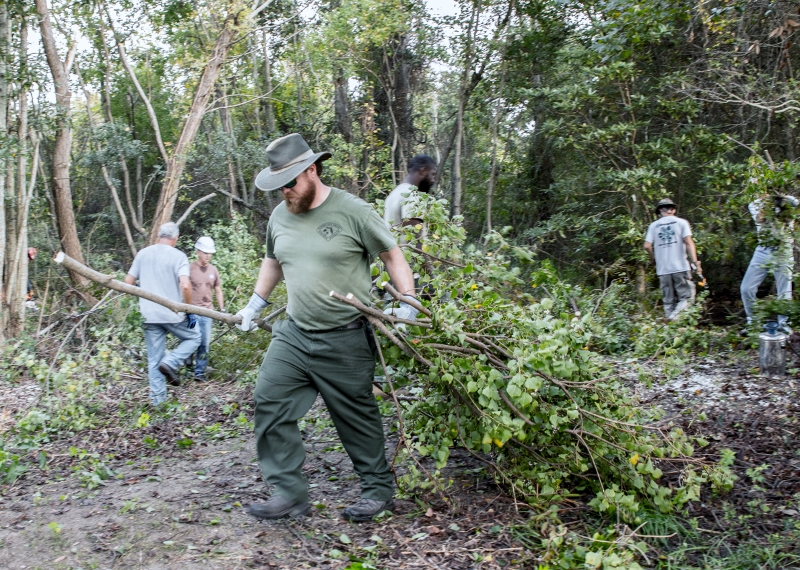
by Rick O'Connor | Jan 27, 2022
What is the Weed Wrangle?
It is a national event held every February where members of local communities visit a public area to remove invasive plants. However, due to COVID, we are again doing it “virtually” this year. Virtually meaning that members of the local community work in their own yards to remove invasive plants. This year in the western Florida panhandle we are targeting the Chinese tallow, but of course you are welcome to remove ANY invasive plant you may have.

The round-ish ovate leaves of the Chinese Tallow.
Photo: Rick O’Connor
How do you DO the Weed Wrangle?
Step 1 – Survey your property to see if you have any Chinese tallow. This tree is also known by many as the “popcorn tree”. You can work with other members on your street who are interested and identify Chinese tallow on your block.
Step 2 – Confirm the identification. If you are sure it is Chinese tallow, and many are very familiar with this plant and is why we have chosen it, you are good to go. If not, you can contact your county extension office for verification.
Step 3 – Report the tree(s) to the national database EDDMapS at www.EDDMapS.org. There is a “report sightings” button on the tool bar. It will ask for latitude and longitude and you can get this information from your phone or a GPS or from google earth if you have it on your computer. Remember to type in longitude as a negative number, -87 in our case, so that it is reported in the correct hemisphere. NOTE: You are not allowed to report plants on someone else’s property without their permission, please get that before you do.
Step 4 – Remove it. Please take photo of the tree(s) BEFORE you remove. Not everyone wants to remove their Chinese tallow. Even though it is an invasive species and listed as a state noxious weed. Many enjoy the tree, and the color changes it provides. There is nothing illegal about having the tree in your yard, so you are fine. If you do choose to remove it there are methods that have been tested that work best. Contact your county extension office for those methods so that you are successful. Please take photo after removal.
Step 5 – Contact me – Rick O’Connor, Escambia County Extension, at roc1@ufl.edu to let me know you which steps you completed. I am tracking participation in this years Weed Wrangle. We will be doing this during the month of February. We also can enter you into a drawing for prizes!
If there are other invasive plants on your property you are interested in removing and want to know the best methods to do so, contact your county extension office and we can provide that for you. It would certainly be included in this years Weed Wrangle.
Thanks for helping stay on top of our invasive species problem.

Members of the Six Rivers CISMA remove Chinese tallow from a city park in Pensacola.
Photo: Kristal Walsh.
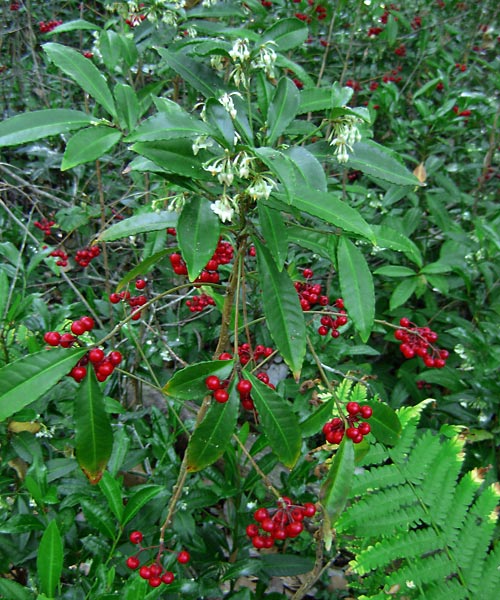
by Rick O'Connor | Jan 20, 2022
EDRR Invasive Species
Coral Ardisia (Ardisia crenata)

photo courtesy of Les Harrison
Define Invasive Species: must have ALL of the following –
- Is non-native to the area, in our case northwest Florida
- Introduced by humans, whether intentional or accidental
- Causing either an environmental or economic problem, possibly both
Define EDRR Species: Early Detection Rapid Response. These are species that are either –
- Not currently in the area, in our case the Six Rivers CISMA, but a potential threat
- In the area but in small numbers and could be eradicated
Native Range:
Japan and northern India
Introduction:
Was introduced intentionally as an ornamental plant in the early 1900s. In 1982 it escaped cultivation and spread through wooded areas of Florida and parts of the Gulf coast.
EDDMapS currently list 2,064 records of coral ardisia. Most are in Florida but there are records in the Gulf states, Georgia, and South Carolina. Records within Florida cover the state, but has not been reported from all counties.
Within Six Rivers CISMA there are 11 records including Baldwin, Santa Rosa, Okaloosa, and Holmes Counties.
Description:
Coral ardisia grows in clumps, many times multi-stemmed in wooded areas. It has long (8”) glossy leaves that are dark green in color and has scalloped margins. The flowers are whiteish pink and droop below the leaf cover. The fruit are bright red berries that also droop from the plant and are present much of the year.
Issues and Impacts:
Like many invasive plants, coral ardisia spreads aggressively replacing native plants where they can. Though no published literature, it is believed to be toxic to livestock, pets, and humans.
It is a Category I invasive plant and a Florida Noxious Weed. It is listed as prohibited by the UF IFAS Assessment.
Management:
Step 1 is to avoid planting coral ardisia in your landscape. It is listed as a Florida noxious weed, and thus should not be sold, but transplanting is prohibited. If it can be easily removed by hand from your landscape, do so before it goes to seed. Be careful not to spread seeds.
Disking and/or burning can be effective however (a) most areas where coral ardisia grows prohibits disking and/or burning and (b) unless you removed all of the deep rhizomes it may return, so annual surveys are still needed.
Chemical treatments typically use the active ingredient triclopyr. This herbicide can be applied directly to the leaves or by applying to the bark when the plant is relatively dry. For large areas needing treatment the formulas may change. Different mixtures can be found in the references below. Annual retreatment may be required. Contact your local county extension office if you have questions.
References
Ardisia crenata. 2022. University of Florida Center for Aquatic and Invasive Plants. https://plants.ifas.ufl.edu/plant-directory/ardisia-crenata/.
Ardisia crenata. 2019. University of Florida IFAS Assessment of Non-Native Plants. https://assessment.ifas.ufl.edu/assessments/ardisia-crenata/.
Sellers, B.A., Enloe, S.F., Minogue, P., Walter, J. 2021. Identification and Control of Coral Ardisia (Ardisia crenata): Potentially Poisonous Plant. University of Florida IFAS Electronic Digital Information System (EDIS) publication #SS AGR-276. https://edis.ifas.ufl.edu/publication/AG281.
Early Detection and Distribution Mapping System (EDDMapS)
https://www.eddmaps.org/
Six Rivers CISMA
https://www.floridainvasives.org/sixrivers/
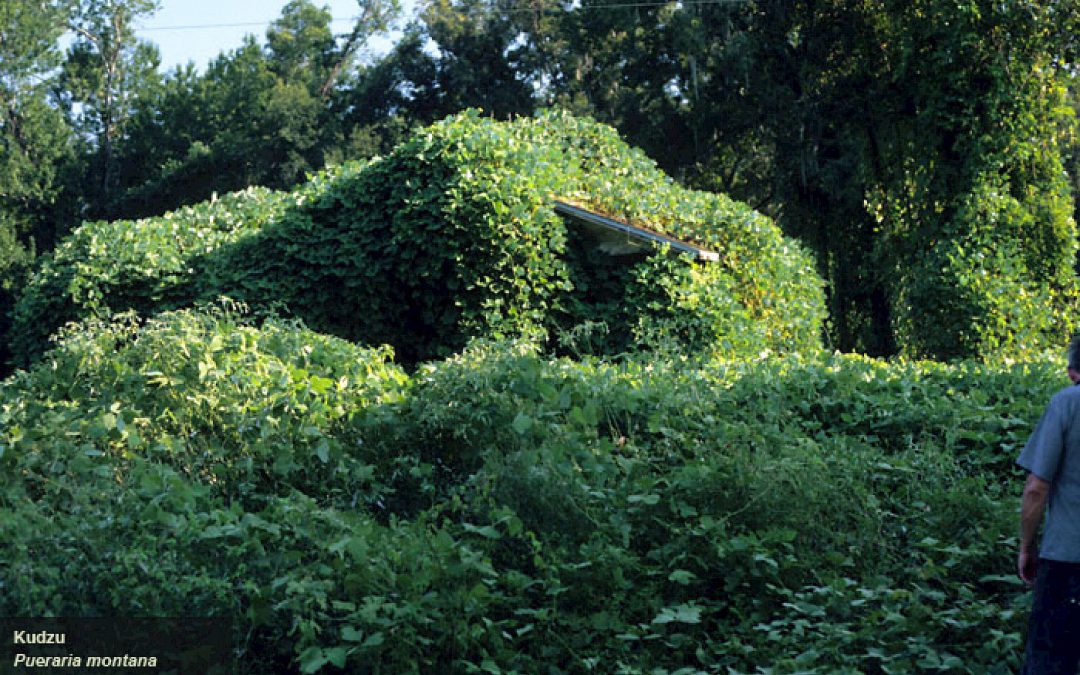
by Rick O'Connor | Jan 13, 2022
Six Rivers “Dirty Dozen” Invasive Species
Kudzu (Pueraria montana)
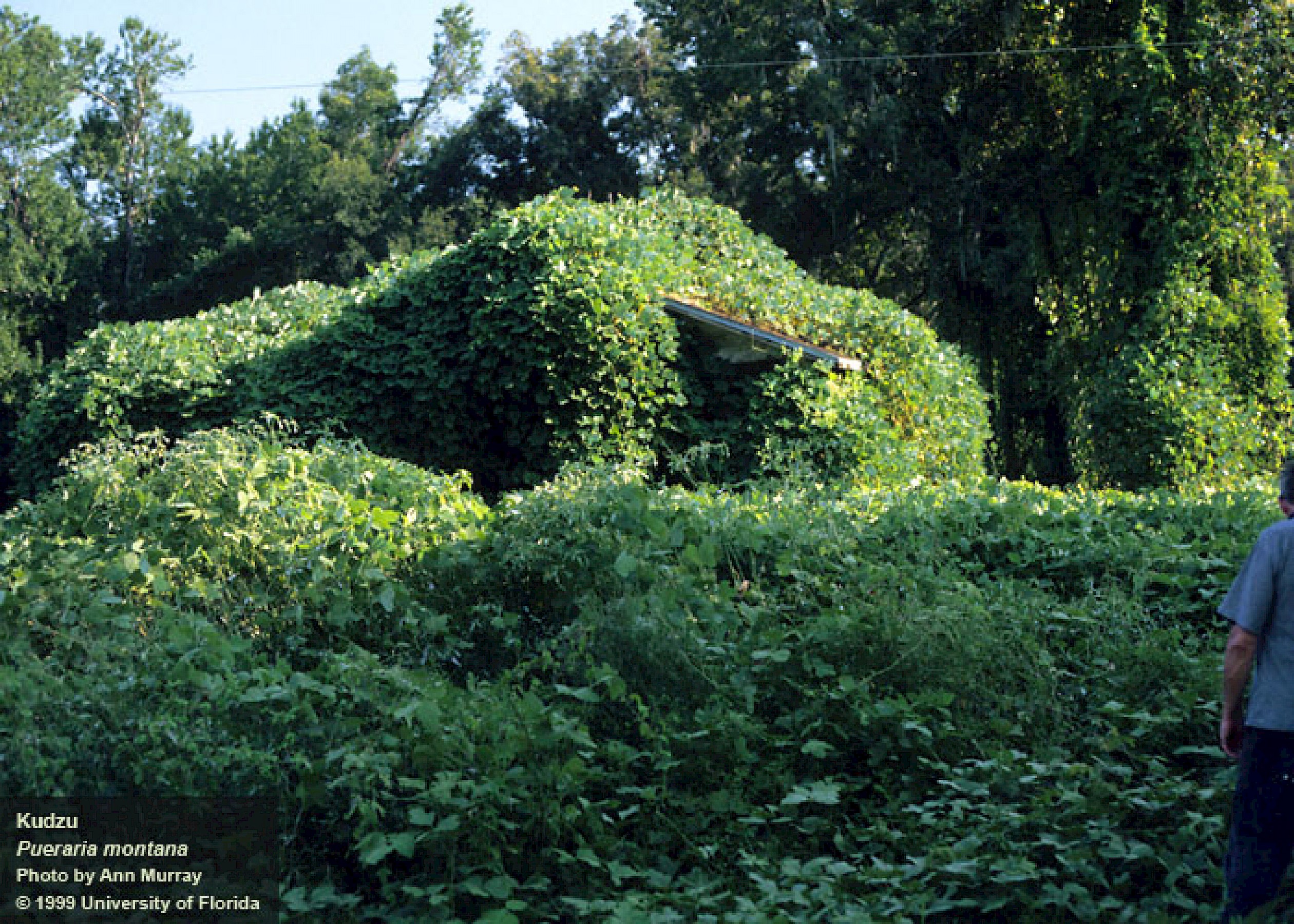
Kudzu is an aggressive growing vine found throughout the southeast.
Photo: UF IFAS Center for Aquatic and Invasive Plants.
Define Invasive Species: must have all of the following –
- Is non-native to the area, in our case northwest Florida
- Introduced by humans, whether intentional or accidental
- Causing either an environmental or economic problem, possibly both
Define “Dirty Dozen” Species:
These are species that are well established within the CISMA and are considered, by members of the CISMA, to be one of the top 12 worst problems in our area.
Native Range:
Eastern Asia.
Introduction:
Kudzu was first brought to the U.S. for the Philadelphia Centennial Exhibition in 1876. Seven years later it was presented at the New Orleans Exhibition. Seed was sold to grow ornamental vines to shade porches and was also tried as livestock feed. It now covers about 2 million acres of forest land in the southern U.S.
EDDMapS currently list 11,288 records of the plant in the U.S. As with many “dirty dozen” species, this is certainly under reported. Most are in the southeastern U.S. but there are records in Kansas, Illinois, and Oregon. It has been reported throughout the state of Florida including the Florida panhandle, and all of the Six Rivers CISMA.
Description:
This is a semi-woody vine that can grow up to 100 feet. Most who have seen it, recognize it immediately. The leaves are large (4”) and alternate on the vine forming three leaflets at each node. The leaves are lobed with hairy margins. The vines can reach 4” in diameter and one stump found in Georgia was 12” in diameter. The flowers are purple in color, hang in clusters, and appear in late summer.
Issues and Impacts:
It grows almost anywhere and over almost anything. Entire buildings have been completely covered by this plant and it has also been known to grow over and uproot trees. Any vegetation it covers will soon die due to a lack of sunlight and it is also known to harbor insects and disease for native legumes, many of which are important agricultural crops, such as soybeans. It is listed as a state noxious weed.
Management:
This is a tough plant to control. It has been reported to grow as much as a foot a day. The root and rhizomes system are extensive and reach depths of 10 feet. There are also tubers that store excess carbohydrates that help with surviving drought, freezing, and even fires.
Herbicides are effective on small patches, though repeated applications may be needed. They can be used on large areas of infestation but will certainly take repeated applications over years and can be very expensive. Many will include burning, disking, or mowing before chemical applications to weaken the root system. Chemicals that have had some success include glyphosate, chlopyraild, metsulfuron, and aminopyralid.
Many have had success using livestock grazing, such as goats or cattle. Research has shown that close grazing, where 80% of more of the plant is removed, can completely eradicate it over a couple of years. One source recommends eight goats / acre for best results. Others have had some success by cutting the plant back (like grazing) during the hottest times of the year.
No biological controls have been approved yet, but research continues.
In Asia the plant is used in a variety of ways including food, fiber, and medicine. These could be options for management as well.
For more information on this Dirty Dozen species, contact your local extension office.
References
University of Florida IFAS Center for Aquatic and Invasive Plants. Kudzu (Pueraria montana). https://plants.ifas.ufl.edu/plant-directory/pueraria-montana/.
Frank, M.S. 2021. Five Facts: Kudzu in Florida. Florida Museum of Natural History. https://www.floridamuseum.ufl.edu/science/five-facts-kudzu-in-florida/.
Early Detection and Distribution Mapping System (EDDMapS)
https://www.eddmaps.org/
Six Rivers CISMA
https://www.floridainvasives.org/sixrivers/











